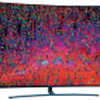Yes, that news title is a bit of a paradox eh? But is the claim really, perhaps OLED quality would describe it better. At the CES, the manufacturer wants to show a TV in which an organic luminescent layer based on quantum dots that provides high-color and high-contrast images.
Samsung apparently wants to rely again on OLEDs: The Korean display specialist uses a blue-glowing organic layer to stimulate quantum dots that produce red and green pixels from the blue light. The advantage over the previous LCD TVs with quantum dots: a viewpoint independent, high-contrast representation. The advantage over previous OLED TVs: extremely rich colors. In addition, the quantum dot OLED combination (QD-OLED) works in an energy-efficient way, as the complete light from the blue "OLED backlight" is used here for image generation. In LCDs, on the other hand, two-thirds of the light is blocked at the color filters and is therefore lost to the display.
The QD OLEDs also require a yellow reflector, which prevents the ambient light from exciting the quantum dots and emitting them, even though the underlying organic layer does not light up. The quantum dots for the red and green subpixels are printed in the pixel grid, while the organic luminescent layer is applied over a large area.
It consists of various organic layers, which can, however, be vapor-deposited cost-effectively and unstructured by means of CVD (Chemical Vapor Deposition) methods. As a result, no metal mask has to be precisely positioned and moved over the large TV substrates in production and, unlike the techniques used for smartphones, no expensive organic material is lost when the luminous layer is applied. Both of these factors led Samsung, among other things, to refrain from developing its 2013 OLED TV with a pixel matrix of red, green and blue organic light dots.
Image: DigiTimes
According to Digitimes, Samsung wants to redesign a generation 8 LCD factory for OLED fab with oxide TFT substrates. Thus, the manufacturer could go relatively quickly into series production. For example, the first samples will be available by mid-2019 and then run 25,000 substrates per month - if six (perfect) TV screens are cut from each substrate, that would be 150,000 TVs per month. By 2020, capacity will be doubled. However, Samsung still has a few technical hurdles to overcome. Samsung plans to apply the organic material to Canon coating machines and print the quantum material on Kateeva machines. What will cost such a QD OLED TV in the end, is still open. The goal can only be to not be significantly above the current OLED prices.
Sources - Heise
Samsung will show 'OLED' TV based on quantum dots


